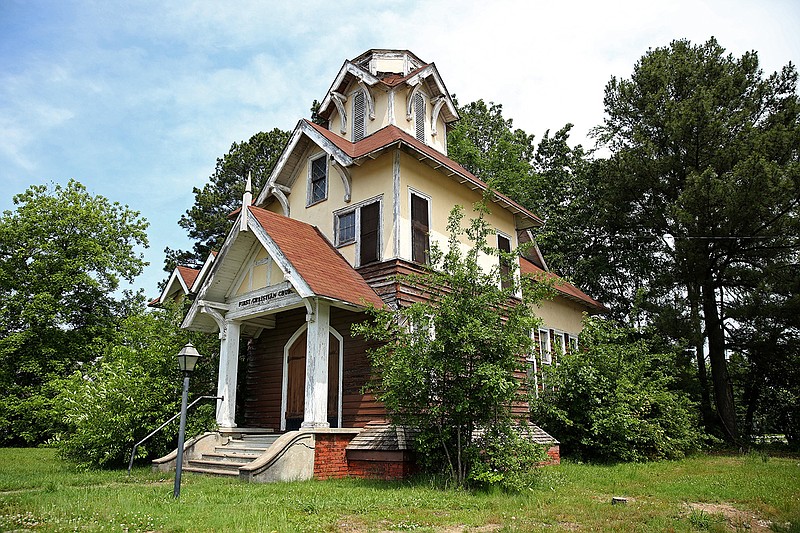A church in Lonoke, a mercantile building in DeValls Bluff and an 1850s farmstead in Stone County have been named by Preserve Arkansas as this year's Most Endangered Places.
"These listings illustrate broader trends throughout the state," said Rachel Patton, executive director of Preserve Arkansas. "We are seeing many religious congregations struggle to maintain their historic facilities, and changes in population distribution require a new development model in rural areas. I am hopeful that we can help find solutions to save these important historic places."
The Most Endangered Places program began in 1999 to raise awareness of historically and architecturally significant properties facing threats such as demolition, deterioration and insensitive development, according to a news release from Preserve Arkansas, the only statewide, nonprofit preservation organization.
Preserve Arkansas solicited nominations, and a selection committee of preservation professionals, architects, historians and Preserve Arkansas members chose properties based on their level of significance, severity of the threat and level of local support. The list is updated annually.
This year's list is being called the "Threatened Three."
FIRST CHRISTIAN CHURCH
First Christian Church in Lonoke, which was designed and built in 1916 by Charles E. Hämm Sr. with assistance from builder Frank Goodbar, was listed in the National Register of Historic Places for its architectural significance.
"The vacant building, now in need of urgent roof repair, is the best example in Lonoke County of a church designed in the Craftsman and Tudor Revival styles," according to the release.
People in the vicinity worked for about 20 years to raise enough money to organize and construct the church, according to https://bit.ly/3NmG5ri.
"The building features battered walls clad in weatherboard on the lower level and stucco with false half-timbering on the upper level and gable ends," according to the website. "The steeply pitched gable-on-hip roof has multiple gabled dormers and exposed rafter tails in the eaves. The church retains its original double-hung wood windows of various sizes and pane arrangements as well as decorative brackets in some gable ends. The corner bell tower is topped by a belfry with gabled dormers on all sides. The top piece of the bell tower, which was octagonal with a crenelated parapet, was removed decades ago due to water leaks."
By the end of the 20th century, the congregation had dwindled to just a few members, according to Preserve Arkansas. The last church service was held in the building around 2005.
"The church interior looks almost exactly like it did on the day of that last service -- there are even wafers in the Communion plate," according to the website. "But time has taken its toll, and the roof is failing, causing water damage to the interior. The building is owned by Mr. Hämm's granddaughter, who grew up in the church and wants to see it restored for community use."
THE ROBINSON BUILDING
The Robinson Building in DeValls Bluff was constructed in 1913. The two-story building anchors the last intact commercial block in the White River town, according to the website. The building housed the Robinson Mercantile on the first floor and a Masonic Lodge on the second floor.
"The Robinson Building had long been vacant and deteriorating," according to Preserve Arkansas. "Exterior bricks were starting to fall, and the building was at risk of demolition. The nonprofit Studio DRIFT, which stands for Developing Rural Infrastructure for Tomorrow, purchased the Robinson Building and two adjacent buildings. Studio DRIFT removed the Robinson Building's severely damaged roof and interior elements, salvaging materials for use in the building's rehabilitation where appropriate. The brick was repointed and the exterior walls stabilized, but the building remains a shell. Additional resources are needed to reconstruct the building's roof and interior for use as a multipurpose space that benefits the community.
"Studio DRIFT's long-range plan is to rehabilitate the entire block, creating a focal point and tourist attraction that can serve a practical need for people looking to ride bike or water trails, explore local cuisine, culture and history, and then ultimately become an economic catalyst for the whole region and spark future businesses and preservation efforts."
NEWTON SUTTERFIELD FARMSTEAD
The Newton Sutterfield Farmstead near Alco in Stone County was built about 1850 by J. Newton Sutterfield.
"Although it is now in a decrepit state, the Sutterfield Farmstead illustrates the hardscrabble existence of farmers in the Arkansas Ozarks and stands as an important example of a vernacular double-pen house," according to the release. "The current owner would like to see the house restored and used to interpret the area's early history."
Although it may have begun as a single "pen," or room, the house was at one time a double-pen, hand-hewn log building, according to a 2003 nomination for the National Register of Historic Places. Around 1900, two rooms were added to the back of the building and the logs were covered with board and batten siding. Photographs show two front doors opening onto a porch the width of the front of the building. A stone chimney is on the right side of the building.
"Sometime before 1950, the house was sheathed in weatherboard on the front elevation and with clapboard on the other three sides giving the building its current appearance," according to the nomination. "The house sits atop a continuous stone foundation and is sheltered by a corrugated metal gable roof."
The farmstead was listed on the National Register in 2003. Several structures that once existed there -- including a blacksmith shop, smokehouse and stone fence -- are no longer there.

